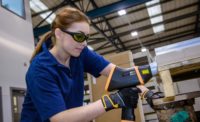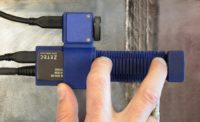ECA Probes Improve Inspection Flexibility—in More Ways than One
Eddy current array results can be saved, shared, stored, processed, and compared at any time.

Flexible ECT probes allow the coils to bend and remain close and nominally perpendicular to the surface.
Eddy current array (ECA) technology has long been used for nondestructive testing in aerospace, power generation, oil and gas, and other industrial applications. It’s a fast, accurate, chemical-free method for detecting surface and sub-surface indications including cracks, pits, corrosion, and damage due to temperature or fatigue.
ECA has the added benefit of generating an electronic inspection record for advanced analysis and reporting, a big advantage over dye penetrant testing (PT), magnetic particle testing (MT), and other types of manual examinations. Unlike PT or MT, ECA results can be saved, shared, stored, processed, and compared at any time. Indeed, with the right surface array probe, software, and handheld eddy current instrument, an operator can set up an inspection quickly, capture more information in a single pass, see results instantly on a C-scan display, and dramatically increase the speed, accuracy, and repeatability of the test.
One practical limitation of ECA technology is that as the operator moves the probe across the surface under test, the excitation coils need to be close to the material for accurate flaw detection and signal quality. It can be a challenge when you’re dealing with complex geometries, different weld shapes and materials, rough surface conditions, and inspection areas that are difficult to reach.
Consider the inspection of a circumferential butt weld joint on a pipe, where the positive curvature of the pipe exterior, the positive curvature of the circumferential weld crown bead, and the negative curvature of the joining area at the toe of the weld intersect. It’s a good example of a complex geometry: the joint between the weld and the base material is difficult for an eddy current probe to reach because of the planar nature of typical array assemblies. In addition, the weld itself is a non-uniform surface.
Thus, there is a need for a probe design that can keep the excitation coils and sensing devices, whether coils or other sensors, closely and properly aligned with the surface of the material as the operator slides it over the surface. Over the years, probe suppliers have come up with a variety of methods to accomplish this.
Customized Probes
One strategy is to design a surface array probe that’s shaped for one specific application or component, like rivets, bolt holes, or something that has to be subjected to repeated nondestructive testing, like wheels, door hinges, or gearing.
Using CAD drawings and 3D printing technology, it’s possible to manufacture an eddy current probe that’s precisely shaped to fit the exact geography you need. Though it’s designed to do only one job, a custom-made probe can be extremely effective at producing consistent data acquisition conditions over and over again.
Flexible Probes
Another approach is to use an ECA probe with a flexible, durable wear surface that allows the coils to bend and remain nominally perpendicular to the surface when that surface is rough, irregular, or complex. In the case of a non-ferromagnetic weld, for example, a flexible surface array probe with just two inches of coverage can encapsulate the weld bead, transition zone, and heat-affected zones in a single pass.
Because this type of flexible probe can conform and adapt to different surfaces and contours, it can handle a range of ECA inspections on the same job ticket: for example, a technician on a flight line can inspect rivets on a curved wing, weld joints on turbine rotors, and the multi-layered skin of a fuselage with the same flexible surface array probe.
One important consideration is the material on the wear surface. The thickness of the wear surface will affect the proximity of the coils to the material as well as the probe’s overall flexibility and eddy current signal quality.
In some cases, the flex circuit may not be durable enough to withstand repeated abrasion against potentially rough metal surfaces. Probe manufacturers offer a variety of materials as a wear surface, including plastic films and abrasion-resistant fabrics. The wear surface may be separate from the flex circuit, which allows it to be easily replaced, or bonded to it, in which case they would need to be replaced as a unit when necessary.

This surface array probe has a pliable wear surface that conforms to the material under test. The type of wear surface you choose will affect the proximity of the coils to the material as well as the probe’s overall flexibility and eddy current signal quality.
Modular Approach
Customized and flexible surface array probes can quickly and accurately test a wide range of materials and geometries but the entire assembly must be replaced if one element of the probe wears out or fails. One new approach to improving the versatility and service life of ECA probes is a modular one.
More Coverage and Versatility
Regardless of whether you use a custom probe shape, a flexible surface array probe, or a modular approach, today’s ECA probes provide greater inspection coverage in a fraction of the time compared to PT, MT, or pencil probes.
The key is to focus on a probe’s flexibility—literally, in terms of the surfaces and geometries it can handle, and in its ability to help technicians be more productive in their inspections while maximizing the value, versatility, signal quality, and service life of the probe.
Looking for a reprint of this article?
From high-res PDFs to custom plaques, order your copy today!





